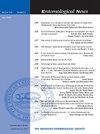1938年关于柯氏锥虫(Derbidae:Otiocerinae:Otiocarini)的地位
IF 0.4
4区 农林科学
Q4 ENTOMOLOGY
引用次数: 1
摘要
德氏稻飞虱属Otiocerus Kirby由15个物种组成,主要分布在美国东部和中美洲(Bourgoi 2022)。Bartlett等人(2014)中发现了美国蟾蜍科的一个属的钥匙,Bartlett等(2011)中也发现了美国东部物种的钥匙。该属的成员(图1、2)很脆弱,长约8-10毫米,头部强烈地向背内侧扁平,并强烈地向前突出,头部背部笔直(侧视图中的尖部呈钝角),触角有附属物(例如,Bartlett等人2014,图64E),翅膀比腹部长得多,通常颜色苍白,翅膀有诊断图案。最相似的属是Apache Kirkaldy属(Bartlett等人,2014年,图67E;红色或玫瑰色,头部背部具正弦状,翅膀顶部向上弯曲)和Shellenius Ball属(Bartlett等人,2014.图67H;头部背部直至弱正弦状,侧视图中顶部圆形)。这些属被认为以若虫的真菌菌丝为食,并可能在腐烂的原木或类似情况下以若虫或成虫的形式越冬。本文章由计算机程序翻译,如有差异,请以英文原文为准。
On the Status of Otiocerus coquebertii rubidus Osborn 1938 (Derbidae: Otiocerinae: Otiocerini)
The derbid planthopper genus Otiocerus Kirby consists of 15 species distributed primarily in the eastern United States and Mesoamerica (Bourgoin 2022). A key to the genus for US Derbidae is found in Bartlett et al. (2014), and a key to eastern US species in Bartlett et al. (2011). Members of the genus (Figs. 1, 2) are fragile, approximately 8-10 mm in length, head strongly dorsoventrally flattened and strongly anteriorly projecting, dorsum of the head straight (fastigium obtusely angular in lateral view), antennae with appendages (e.g., Bartlett et al. 2014, fig. 64E), wings much longer than the abdomen, usually pale in coloration with diagnostically patterned wings. The most similar genera are Apache Kirkaldy (Bartlett et al. 2014, fig. 67E; red or rose in coloration, dorsum of head sinuate, the apex of wings inflected upward) and Shellenius Ball (Bartlett et al. 2014, fig. 67H; dorsum of the head straight to weakly sinuate, fastigium rounded in lateral view). These genera are assumed to feed on fungal hyphae as nymphs and may overwinter as nymphs or adults in rotting logs or similar situations.
求助全文
通过发布文献求助,成功后即可免费获取论文全文。
去求助
来源期刊

Entomological News
生物-昆虫学
CiteScore
1.10
自引率
25.00%
发文量
17
期刊介绍:
Contributions are accepted on any of the aspects of systematics and taxonomy of insects. This includes: taxonomic revisions, phylogenetics, biogeography and faunistics, and descriptive morphology of insects. Taxonomic papers describing single species are acceptable if such a study is sufficiently justified, however, comprehensive studies that provide a comparative, integrated study of insect systematics and taxonomy will get priority.
 求助内容:
求助内容: 应助结果提醒方式:
应助结果提醒方式:


